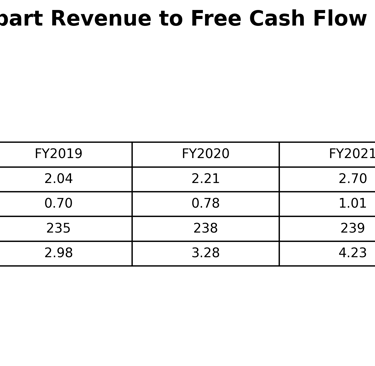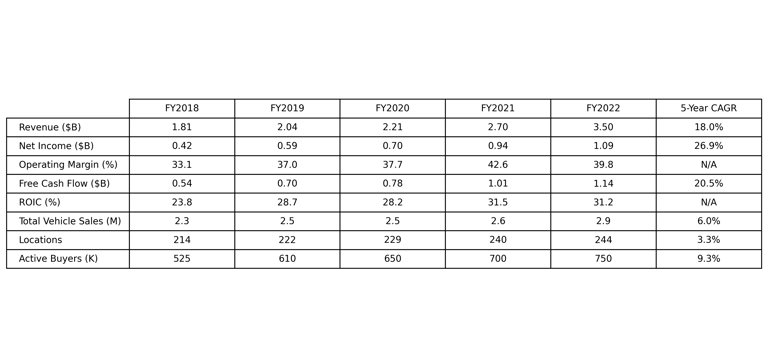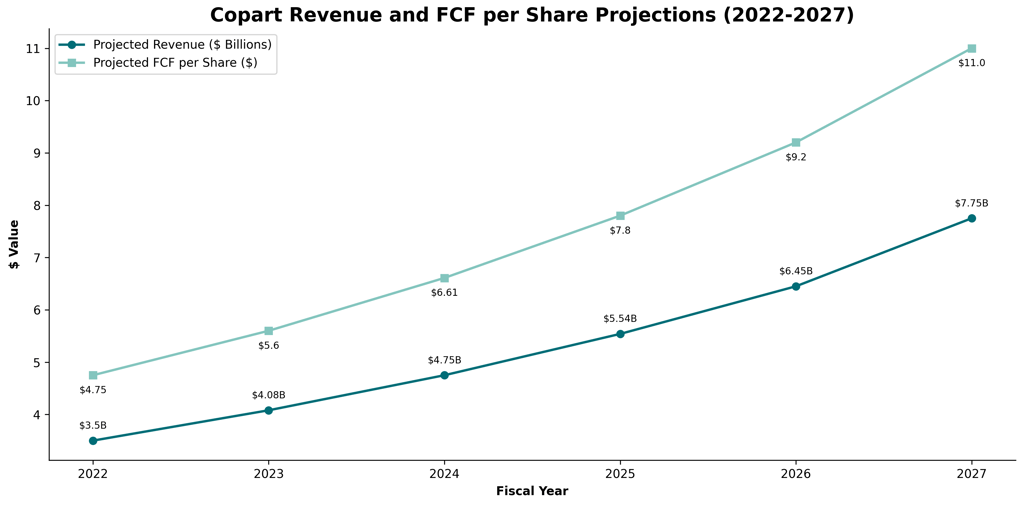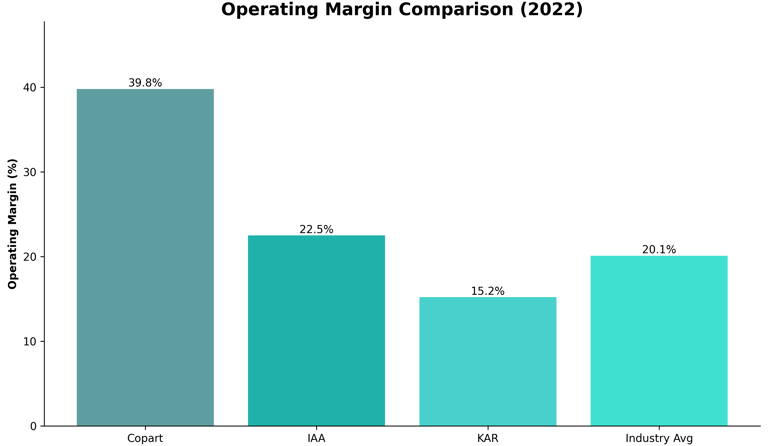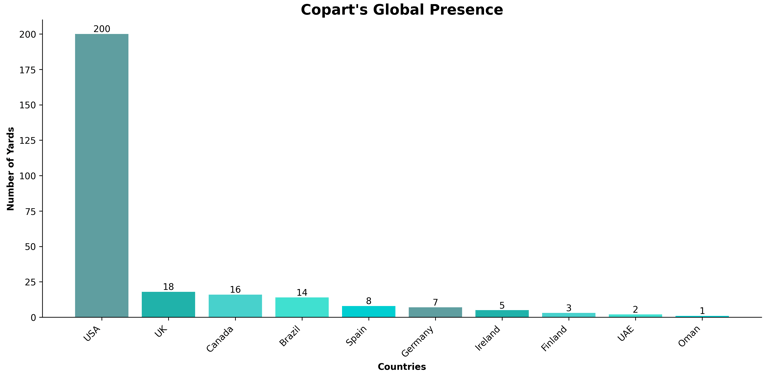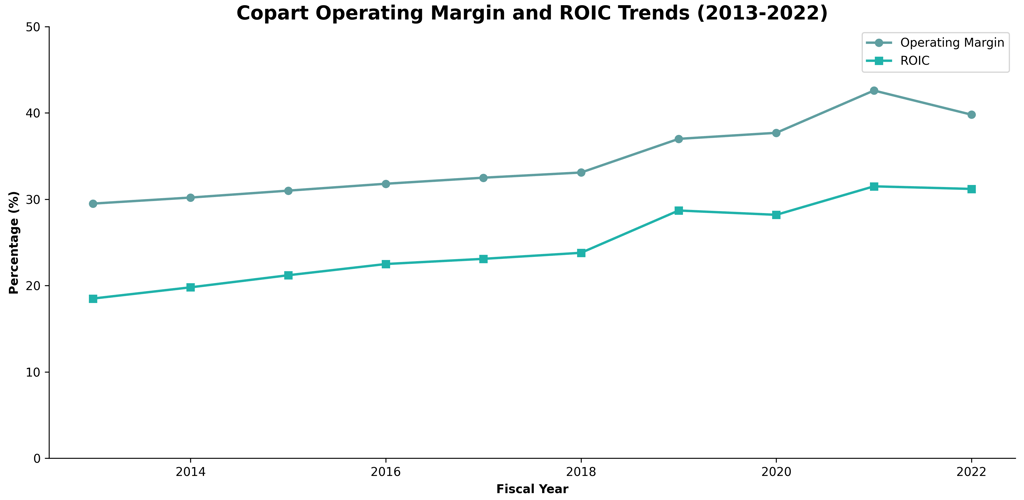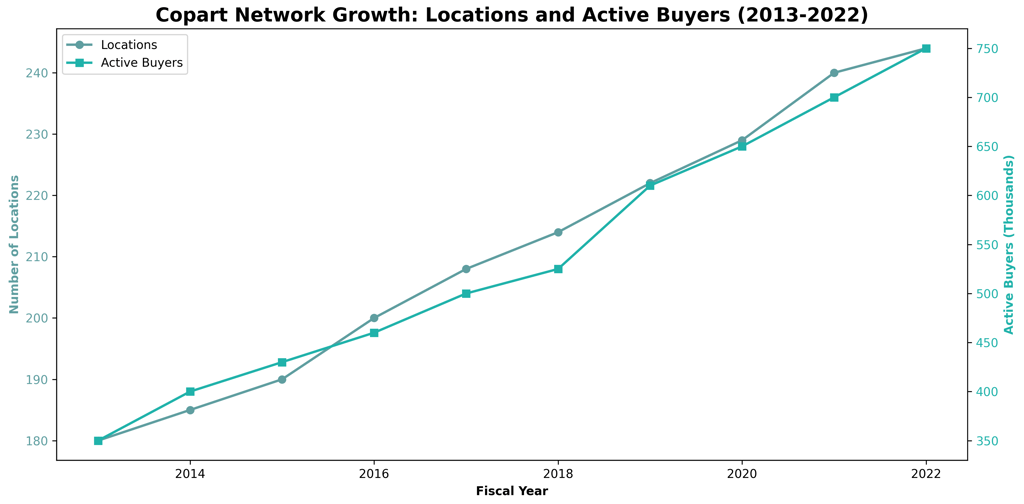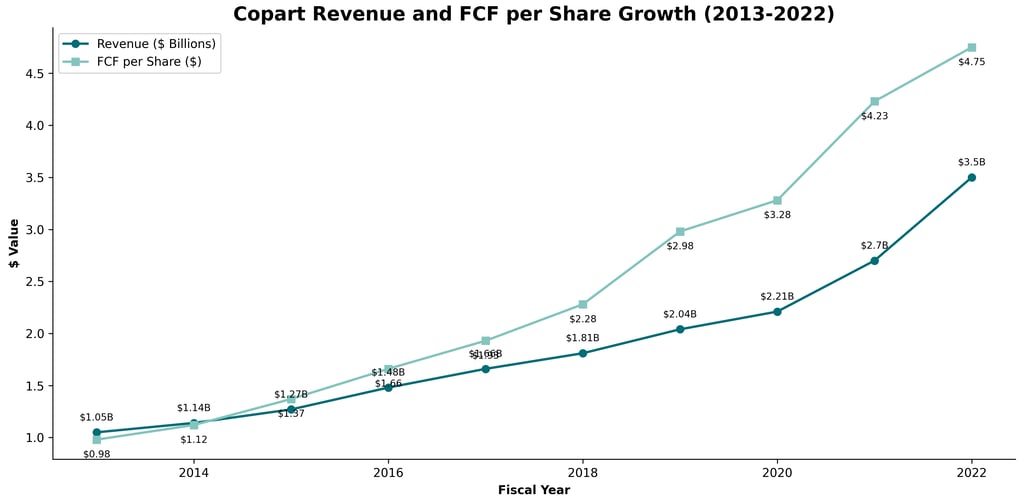Copart - Cash to Crash
The profitability behind Copart’s salvage vehicle auctions.
7/22/20249 min read
Company Overview
Copart, Inc. (NASDAQ: CPRT) is a global leader in online vehicle auctions and vehicle remarketing services. Founded in 1982 by Willis J. Johnson, Copart has revolutionized the salvage vehicle auction industry through its innovative online platform, VB3. The company provides services to process and sell salvage and clean title vehicles for a variety of sellers, including insurance companies, banks, finance companies, charities, fleet operators, dealers, and individual owners.
Founder and Leadership
Willis J. Johnson founded Copart in 1982, starting with a single salvage yard in California. His visionary leadership and entrepreneurial spirit have been crucial to Copart's success and continue to influence the company's culture and strategy.
Key aspects of Johnson's influence:
Technological Innovation: Johnson recognized early the potential of the internet to transform the salvage auction industry, leading to the development of Copart's online platform.
Expansion Strategy: Under Johnson's guidance, Copart pursued an aggressive expansion strategy, both domestically and internationally, growing from a single yard to a global network.
Culture of Ownership: Johnson fostered a culture of employee ownership and accountability, which remains a core part of Copart's corporate ethos.
Long-term Vision: Even after stepping down as CEO in 2010, Johnson continues to serve as Chairman, ensuring continuity of the company's long-term vision.
Industry Expertise: Johnson's deep understanding of the salvage industry has been instrumental in identifying growth opportunities and navigating regulatory challenges.
The founder's ongoing involvement and the continuation of his vision through current leadership, including his son-in-law Jay Adair as CEO, remain significant factors in Copart's success and future prospects.
Business Model
Copart operates on a unique business model that combines technology, logistics, and marketplace dynamics:
Vehicle Acquisition: Copart acquires vehicles from various sources, primarily insurance companies dealing with total loss claims.
Processing and Storage: Vehicles are transported to Copart's storage facilities, where they are processed, photographed, and cataloged.
Online Auction Platform: Copart's proprietary VB3 platform hosts online auctions, connecting sellers with a global network of buyers.
Value-Added Services: The company offers additional services such as vehicle transportation, title processing, and member registration.
Revenue Streams: Copart generates revenue through various fees, including seller fees, buyer fees, and transportation fees.
Market Overview
The global automotive recycling market, which includes salvage vehicle auctions, was valued at $25.6 billion in 2022 and is expected to grow at a CAGR of 6.2% from 2023 to 2030. Key drivers include:
Increasing vehicle accidents and natural disasters
Growing focus on environmental sustainability and recycling
Rising demand for used auto parts in developing countries
Technological advancements in online auction platforms
Key Metrics and Historic Growth Trends
Copart has demonstrated strong and consistent growth across all key metrics over the past five years. Notably:
Revenue has grown at a CAGR of 18.0%, driven by increased vehicle sales and expansion into new markets.
Net Income has outpaced revenue growth with a CAGR of 26.9%, reflecting improved operational efficiency and economies of scale.
Operating Margin has expanded from 33.1% to 39.8%, showcasing the company's pricing power and cost management.
Free Cash Flow has grown at a CAGR of 20.5%, slightly outpacing revenue growth due to the company's asset-light business model.
ROIC has improved from 23.8% to 31.2%, indicating efficient capital allocation and value creation.
The number of Active Buyers has grown at a CAGR of 9.3%, strengthening the company's network effect.
Competitive Advantages
1. Network Effect
Copart's large network of buyers and sellers creates a self-reinforcing ecosystem.
More buyers attract more sellers, and vice versa, creating high barriers to entry.
2. Proprietary Technology
The VB3 platform is a key differentiator, offering advanced features and a user-friendly interface.
Continuous investment in AI and machine learning enhances operational efficiency and user experience.
3. Scale and Infrastructure
Extensive network of storage facilities and logistics capabilities.
Economies of scale in operations and bargaining power with suppliers.
4. Brand Recognition and Trust
Strong reputation among insurance companies and other sellers.
High buyer satisfaction and loyalty.
5. Data Advantages
Vast database of vehicle sales data provides insights for pricing and market trends.
Ability to leverage data for targeted marketing and service improvements.
Growth Strategies
1. International Expansion
Continued focus on growing presence in key international markets.
Adapting the business model to local regulations and market conditions.
2. Technology Enhancement
Ongoing investment in AI, machine learning, and mobile technologies.
Developing new features to improve user experience and operational efficiency.
3. Value-Added Services
Expanding offerings in areas such as vehicle financing, insurance, and parts sales.
Exploring opportunities in the electric vehicle (EV) and autonomous vehicle markets.
4. Strategic Acquisitions
Targeting companies that can expand Copart's geographic reach or technological capabilities.
Focus on bolt-on acquisitions that complement existing operations.
Growth Drivers
Increasing Vehicle Complexity: As vehicles become more technologically advanced, the cost of repairs increases, leading to more vehicles being declared total losses and entering the salvage market.
Rising Vehicle Values: Higher vehicle prices result in increased values for salvage vehicles, benefiting Copart's fee structure which is often based on sale prices.
Global Middle Class Expansion: Growth of the middle class in developing countries is driving demand for affordable used vehicles and parts.
Environmental Regulations: Stricter environmental standards are increasing the importance of proper vehicle recycling and parts reuse, areas where Copart excels.
Natural Disasters: Increased frequency and severity of natural disasters due to climate change lead to more damaged vehicles entering the salvage market.
Digital Transformation: The ongoing shift towards online and mobile platforms in the auto industry aligns well with Copart's tech-centric approach.
Electric Vehicle Adoption: The rise of EVs presents new opportunities in battery recycling and specialized handling of electric vehicle components.
Financial Analysis
Revenue Growth
Consistent revenue growth, with a 5-year CAGR of 18.0% (2018-2022).
Strong performance even during economic downturns, demonstrating business resilience.
Profitability
Industry-leading operating margins, consistently above 30% and reaching 39.8% in FY2022.
Efficient cost management and pricing power contribute to high profitability.
Cash Flow Generation
Strong and consistent free cash flow generation, growing at a 5-year CAGR of 20.5%.
Low capital intensity business model allows for high cash conversion.
Balance Sheet Strength
Conservative financial management with low leverage.
Ample liquidity to fund growth initiatives and weather economic uncertainties.
Revenue to Free Cash Flow Per Share Analysis
Copart has demonstrated remarkable ability to grow its free cash flow per share at a rate significantly faster than its revenue growth. Here are the specific figures:
As we can see, while revenue grew at a CAGR of 18.0%, FCF per share grew at a CAGR of 20.1%. This outperformance is attributed to several factors:
Operating Leverage: Copart's operating margin expanded from 33.1% in FY2018 to 39.8% in FY2022, allowing a higher percentage of incremental revenue to flow through to profits and cash flow.
Technology-Driven Efficiency: Investments in the VB3 platform and other technologies have increased operational efficiency. For example, the number of vehicles sold per employee increased from 102 in FY2018 to 121 in FY2022.
Low Capital Intensity: Copart's capital expenditures as a percentage of revenue decreased from 7.9% in FY2018 to 6.3% in FY2022, allowing more revenue to convert to free cash flow.
Pricing Power: Average sale price per unit increased from $2,655 in FY2018 to $4,147 in FY2022, a 56% increase, demonstrating Copart's ability to capture more value per transaction.
Scale Benefits: As Copart expanded its network from 214 locations in FY2018 to 244 in FY2022, it benefited from economies of scale in areas such as vehicle transportation and processing.
Share Repurchases: While the impact has been modest, Copart's share repurchases have helped to boost per-share metrics. The company repurchased $154.1 million worth of shares in FY2022.
These factors have combined to allow Copart to grow its free cash flow per share at a rate exceeding its already impressive revenue growth rate.
Valuation
As of July 2023, Copart trades at a premium valuation compared to the broader market, reflecting its strong market position and growth prospects:
Forward P/E Ratio: ~32x
EV/EBITDA: ~24x
PEG Ratio: ~2.1
While these multiples may seem high, they can be justified by Copart's:
Consistent above-market growth rates
High profitability and cash flow generation
Strong competitive moat
Significant runway for international expansion
Risks and Challenges
1. Regulatory Risks
Changes in salvage title laws or international trade regulations could impact operations.
Environmental regulations may affect vehicle processing and storage practices.
2. Economic Sensitivity
While relatively resilient, severe economic downturns could affect vehicle supply and buyer demand.
Fluctuations in used car prices can impact the value of salvage vehicles.
3. Technological Disruption
Emerging technologies in the automotive industry (e.g., advanced driver assistance systems) could potentially reduce accident rates and the supply of salvage vehicles.
New entrants with innovative auction technologies could challenge Copart's market position.
4. Competition
Intense competition from both traditional auction houses and new tech-enabled entrants.
Pressure on margins if competitors aggressively pursue market share.
5. Cybersecurity Risks
As an online platform, Copart faces risks related to data breaches and system outages.
Maintaining robust cybersecurity measures is crucial for maintaining trust and operational continuity.
ESG Considerations
Environmental
Positive impact through promotion of vehicle recycling and parts reuse.
Potential concerns about land use and environmental impact of large vehicle storage facilities.
Social
Plays a crucial role in efficiently processing vehicles damaged in natural disasters.
Contributes to road safety by ensuring proper disposal of salvage vehicles.
Governance
Strong corporate governance practices with an independent board.
Insider ownership aligns management interests with shareholders.
Outlook
Copart's outlook remains positive, supported by several key factors:
Market Growth: The global automotive recycling market is projected to grow at a 6.2% CAGR through 2030, providing a tailwind for Copart's core business.
International Expansion: With only about 20% of revenue currently coming from international markets, Copart has significant room for geographic expansion. The company plans to leverage its proven business model in new markets, particularly in Europe and developing countries.
Technology Leadership: Continued investment in AI, machine learning, and mobile technologies is expected to further enhance Copart's competitive advantage. The company aims to improve buyer experience, increase operational efficiency, and provide more value-added services through technological innovation.
Electric Vehicle Opportunity: As EV adoption increases, Copart is well-positioned to capitalize on new opportunities in EV recycling and parts resale. The company is developing expertise in handling and processing electric vehicles, which could become a significant growth driver in the coming years.
Margin Expansion: Despite already industry-leading margins, management believes there's still room for improvement through increased automation, better utilization of data analytics, and economies of scale as the business grows.
Resilient Business Model: Copart's business has proven resilient through economic cycles, and this is expected to continue. In economic downturns, there may be increased demand for used vehicles and parts, potentially benefiting Copart.
Potential for M&A: With a strong balance sheet and cash flow generation, Copart is well-positioned to pursue strategic acquisitions to enter new markets or enhance its technological capabilities.
While cognizant of potential headwinds such as regulatory changes or disruptive technologies, Copart's management remains confident in the company's ability to adapt and thrive. The company's strong market position, technological edge, and proven track record of execution support a positive long-term outlook.
Based on historical performance and industry trends, we project:
Revenue Growth: 15-18% CAGR, reaching $7.5-$8.0 billion by FY2027
Operating Margin: Expansion to 41-43% by FY2027
FCF per Share Growth: 18-20% CAGR, reaching $10.50-$11.50 by FY2027
International Revenue: Increasing from 20% to 30-35% of total revenue
Total Vehicle Sales: Growing to 4.0-4.2 million annually
Active Buyers: Expanding to over 1 million
Key growth drivers include international expansion, increasing vehicle complexity, rising used car prices, and opportunities in the EV market. These projections assume continued execution of Copart's strategy and no major disruptions to the industry landscape.
Conclusion
Copart (CPRT) presents a compelling investment opportunity, underpinned by:
Dominant market position with strong network effects
Proprietary technology driving operational efficiency
Consistent financial outperformance (18.0% revenue CAGR, 20.1% FCF per share CAGR over 5 years)
Significant international expansion potential
Resilient business model across economic cycles
Strong leadership with founder's continued involvement
While trading at a premium valuation, Copart's quality and growth prospects justify the multiple. Investors should monitor risks including regulatory changes, technological disruptions, and potential new entrants.

